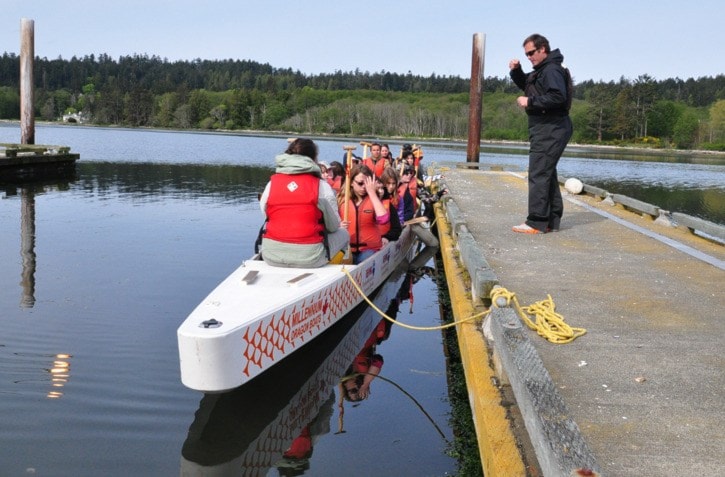With noisy, excited energy, a boatload of school kids dig their paddles into the Esquimalt Lagoon and glide their dragon boat across a living classroom.
It’s calm and warm, a perfect day to be on the water. On the rudder, Brett Malcolm, with Go Rowing and Paddling Canada, guides Grade 6 Lansdowne kids toward an estuary teeming with seagulls, then a sandbar littered with black sand dollars and scuttling dungeness crabs.
Launched from the docks at Royal Roads University, the long-running eco-rowing program gives youth a hands-on look at life in the migratory bird sanctuary. After this month, the program faces an uncertain future, while competitive rowing on the lagoon will come to an end.
The RRU boathouse, the nexus of rowing and paddling programs on the lagoon, offered storage for dozens of long, sleek sculls, oars and lifejackets. The university is reclaiming the 22-year-old building at the end of May for undetermined institutional uses, possibly a First Nations learning centre.
“We’re thankful for what Royal Roads has provided us,” Malcolm says. “But it’s such a shame if they have to end this educational program.”
The boathouse is one of the rare buildings on the campus not under a heritage designation and that could be altered for other educational or administrative purposes.
Even with the recent opening of the Learning and Innovation Centre, RRU officials say the university is squeezed for space. More than 2,000 students enter the campus for 45 residency intakes per year, compared with 350 students 15 years ago.
“We have real and legitimate requirements for space by virtue of our growth,” says Paul Corns, RRU associate vice-president of community relations. “There are significant constraints on developing on a natural heritage property.”
The boathouse now sits largely empty, waiting for renovations, but the university is allowing Go Rowing to store a few boats outside for now. Most of its gear is crammed into its Gorge Waterway facility. Competitive rowing programs at Belmont, Dunsmuir and John Stubbs schools didn’t continue after last winter after it became clear Go Rowing would lose its lease.
“It’s been a 10 year relationship, a good relationship and we’re sorry to see them go,” Corns says. “But the space requirements have forced our hand. It’s been a difficult transition for both sides.”
Steve Frisch, executive director of Go Rowing and Paddling Canada, says a property developer in Sooke is interested in hosting a boathouse, which offers hope to keep rowing programs afloat.
But the Esquimalt Lagoon is one of those rare settings that is ecologically rich, safe for boating and relatively accessible for many schools, Frisch says. Over the school year, hundreds of students from across the region participate in eco-rowing, many who had never set foot in a boat before.
“It’s remarkable to see kids with no experience in boats learn how to work together,” Frisch says. “And hundreds of kids see and touch and learn about the lagoon. They end up understanding the lagoon better than the rest of us.”
Reclaiming the boathouse sheds light on competing priorities within the university. Pressure for office and teaching space is ever growing, while as a federal heritage site, Royal Roads has a limited rein on what and where it can build — only certain areas of the upper campus are considered “developable land.” It has set out to improve its relationship with aboriginal communities, and establishing a learning space is part of that strategy.
But RRU also prides itself as an environmentally progressive institution. Planning an environmental centre bearing his name, the university's identity has become embedded with artist and naturalist Robert Bateman, who has championed a prolific drive to reconnect children with nature, a mandate that meshes with youth programs at the lagoon.
“The biodiversity they experience is unbelievable. Kids see mink crawling by, or river otters swimming by. Wildlife is really present here,” says Nikki Wright, executive director of SeaChange Marine Conservation Society.
Wright runs the “eco” end of eco-rowing and operates a classroom laboratory in storage area attached to a former boathouse, now transformed into office space. Her makeshift lab comes complete with a saltwater ecosystem tank and microscopes. Kids collect water samples and conduct research to gauge the health of the lagoon – 10 being healthiest, it usually scores between eight and nine.
Corns says RRU is committed to retaining environmental education for children on campus grounds and is working in close collaboration with SeaChange Marine.
“We are looking for appropriate space (for students) to sample the lagoon and discover the natural wonders that exist on campus,” Corns says. “We are committed to working with (SeaChange) to find the appropriate accommodations.”
Wright agrees that RRU sees profound value in environmental education for youth on the property, but without boating, a fundamental pillar of the current program is missing. The university has the only publicly accessible docks on the lagoon.
“For our program it’s about the boats, the dock and the wetland. These are so incredibly valuable to us,” Wright says. “It’s unclear how we’ll do the boating program. I’m not sure what this will look like next year.”
editor@goldstreamgazette.com
